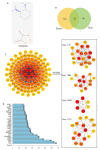[Synergistic effect of polysaccharide from Trichoderma pseudokoningii and oxaliplatin on colorectal cancer cells in vitro]
- PMID: 33963708
- PMCID: PMC8110445
- DOI: 10.12122/j.issn.1673-4254.2021.04.04
[Synergistic effect of polysaccharide from Trichoderma pseudokoningii and oxaliplatin on colorectal cancer cells in vitro]
Abstract
Objective: To explore the synergistic inhibitory effect of polysaccharide from Trichoderma pseudokoningii (EPS) and oxaliplatin (Oxa) on colorectal cancer (CRC) HCT116 cells.
Objective: HCT116 cells were treated with 8 μg/mL Oxa and 100 μg/mL EPS alone or in combination, and the changes in cell viability was assessed with CCK-8 assay. CompuSyn software was used for fitting the Fa-CI curve to evaluate the combined effect of the two agents. Flow cytometry was performed to analyze cell apoptosis and cell cycle changes, and wound healing assay and Transwell assay were used to examine the migration ability of the treated cells. Oxa- and EPS-related genes and CRC-related genes were intersected for protein-protein interaction (PPI) analysis and GO and KEGG enrichment analyses.
Objective: Treatment with Oxa alone or in combination with EPS significantly inhibited the viability of HCT116 cells in a dose- and time-dependent manner, and the two agents exhibited a significant synergistic effect (CI < 1). The combined treatment with Oxa and EPS resulted in a significantly higher total cell apoptosis rate and a higher percentage of cells in S phase than Oxa alone and the control treatment (P < 0.05). EPS and Oxa alone both inhibited the migration of HCT116 cells, and their combination produced a stronger inhibitory effect. GO enrichment analysis of the key genes related with Oxa, EPS and CRC suggested that these genes were involved mainly in such biological processes as exogenous apoptosis signaling, cell response to chemical stress, and reactive oxygen metabolism; KEGG analysis showed that these genes were involved in the pathways of drug resistance, apoptosis and angiogenesis.
Objective: EPS and Oxa can synergistically inhibit the proliferation of HCT116 cells possibly through the PI3K-Akt, MAPK, VEGF, and p53 signaling pathways.
目的: 探讨拟康氏木霉胞外多糖(EPS)联合奥沙利铂(Oxa)用药对结肠癌细胞HCT116的协同抑制作用。
方法: 实验分为Control组(0 μg/mL)、Oxa组(8 μg/mL Oxa)、EPS组(100 μg/mL EPS)、EPS+Oxa组(8 μg/mL Oxa+100 μg/mL EPS)。CCK-8检测细胞活力,CompuSyn软件拟合Fa-CI曲线评价联用效果。流式检测凋亡和周期、划痕实验和transwell实验检测细胞迁移能力,Oxa和EPS相关基因与结直肠癌相关基因取交集进行PPI分析以及GO和KEGG富集分析。
结果: Oxa单用或与EPS联用处理HCT116细胞,均可使HCT116细胞活力受到抑制,并呈现剂量与时间依耐性,两者联用有明显的协同作用(CI < 1)。两药联用组的细胞总凋亡率与Oxa组以及对照组比较均显著升高(P < 0.05);联合用药组处于S期的比例高于其他各组。EPS和Oxa均具有抑制HCT116细胞迁移的作用,两者联用后抑制作用更为明显。KEGG分析显示主要涉及耐药、凋亡、血管新生等通路。
结论: EPS联合奥沙利铂可协同抑制HCT116细胞增殖,促进该细胞凋亡和细胞S周期阻滞、抑制细胞迁移,铂耐药、PI3K-Akt、MAPK等信号通路发挥了关键作用。
Keywords: Trichoderma pseudokoningii; colorectal cancer; oxaliplatin; polysaccharide; synergy.
Figures









Similar articles
-
Lycium barbarum polysaccharide reverses drug resistance in oxaliplatin-resistant colon cancer cells by inhibiting PI3K/AKT-dependent phosphomannose isomerase.Front Pharmacol. 2024 Mar 21;15:1367747. doi: 10.3389/fphar.2024.1367747. eCollection 2024. Front Pharmacol. 2024. PMID: 38576495 Free PMC article.
-
The expression of exosomal and cellular miRNAs in predicting oxaliplatin resistance in colorectal cancer cells: an in silico and in vitro study.BMC Cancer. 2025 Jan 9;25(1):46. doi: 10.1186/s12885-024-13392-2. BMC Cancer. 2025. PMID: 39789474 Free PMC article.
-
Salinomycin and oxaliplatin synergistically enhances cytotoxic effect on human colorectal cancer cells in vitro and in vivo.Sci Rep. 2025 Apr 23;15(1):14056. doi: 10.1038/s41598-025-98633-5. Sci Rep. 2025. PMID: 40269151 Free PMC article.
-
Resveratrol elicits anti-colorectal cancer effect by activating miR-34c-KITLG in vitro and in vivo.BMC Cancer. 2015 Dec 16;15:969. doi: 10.1186/s12885-015-1958-6. BMC Cancer. 2015. PMID: 26674205 Free PMC article.
-
IFI6 Downregulation Reverses Oxaliplatin Resistance of Colorectal Cancer Cells by Activating the ROS-Induced p38MAPK Signaling Pathway.Biol Pharm Bull. 2023;46(1):26-34. doi: 10.1248/bpb.b22-00439. Biol Pharm Bull. 2023. PMID: 36596524
References
-
- Virostko J, Capasso A, Yankeelov TE, et al. Recent trends in the age at diagnosis of colorectal cancer in the US national cancer data base, 2004-2015. Cancer. 2019;125(21):3828–35. doi: 10.1002/cncr.32347. [Virostko J, Capasso A, Yankeelov TE, et al. Recent trends in the age at diagnosis of colorectal cancer in the US national cancer data base, 2004-2015[J]. Cancer, 2019, 125(21): 3828-35.] - DOI - PMC - PubMed
-
- Meester RGS, Peterse EFP, Knudsen AB, et al. Optimizing colorectal cancer screening by race and sex: Microsimulation analysis Ⅱ to inform the american cancer society colorectal cancer screening guideline. Cancer. 2018;124(14):2974–85. doi: 10.1002/cncr.31542. [Meester RGS, Peterse EFP, Knudsen AB, et al. Optimizing colorectal cancer screening by race and sex: Microsimulation analysis Ⅱ to inform the american cancer society colorectal cancer screening guideline[J]. Cancer, 2018, 124(14): 2974-85.] - DOI - PMC - PubMed
-
- Kotwal AA, Schonberg MA. Cancer screening in the elderly: a review of breast, colorectal, lung, and prostate cancer screening. http://europepmc.org/abstract/MED/28731949. Cancer J. 2017;23(4):246–53. [Kotwal AA, Schonberg MA. Cancer screening in the elderly: a review of breast, colorectal, lung, and prostate cancer screening[J]. Cancer J, 2017, 23(4): 246-53.] - PMC - PubMed
MeSH terms
Substances
Supplementary concepts
LinkOut - more resources
Full Text Sources
Medical
Research Materials
Miscellaneous
